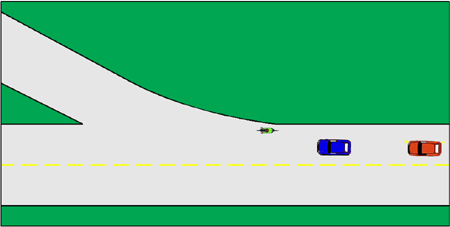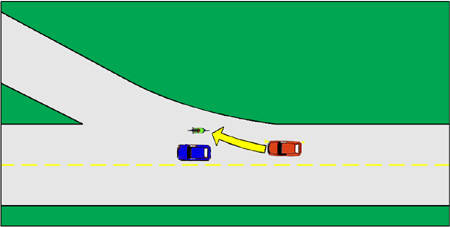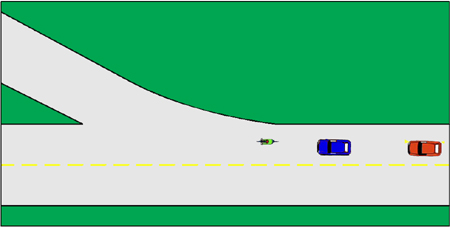A case for taking the lane
 Mon, March 22, 2010
Mon, March 22, 2010 Near my home is a busy main street that I cannot avoid each time I go out for a ride. On my way home I always have to negotiate a place where the road splits; I go straight, but there is another road that goes off at a slight tangent to the right.
The speed limit is 45 mph and vehicles making this right turn do not slow to take it, they use it like a freeway off ramp. There is a situation where all traffic is traveling in the same direction; some go straight, some peel off to the right.

Illustrated above is a scenario where I am riding close to the right hand edge of the road and intend to go straight; the blue car about to pass me is also going straight. However, a red car following is turning right.
The driver of the red car probably can’t see me at this point; the blue car is obstructing his view; remember both cars are traveling at 45 mph which is about twice my speed.
Therefore in the next few seconds both cars remain at the same distance apart from each other, but they have traveled twice the distance I have, and we are all roughly is this next position.

The blue car is passing, and the red car is now on a collision course with me. He may have seen me by now, but given his speed and his reaction time; at best it is going to be a close call.
The Solution
I am very much aware of this possibility, and before the road splits I look behind for a gap in traffic. As soon as it is safe to do so, I give a hand signal and move over to the left; taking up about a third of the lane.
 Now the blue car will probably slow and stay behind me (Above.) ; and becomes my safety buffer. The red car is no danger to me, and it is obvious the driver of the blue car that I intend to go straight.
Now the blue car will probably slow and stay behind me (Above.) ; and becomes my safety buffer. The red car is no danger to me, and it is obvious the driver of the blue car that I intend to go straight.
 Even if the blue car decides to go around me,(Above.) his action of swinging wide and crossing the center line, alerts the driver of the red car of my presence. Plus because I am riding more to the center of the lane, there is more room for the red car to pass me on the right.
Even if the blue car decides to go around me,(Above.) his action of swinging wide and crossing the center line, alerts the driver of the red car of my presence. Plus because I am riding more to the center of the lane, there is more room for the red car to pass me on the right.
Of course there is always the possibility the red car will still try to go around me then turn right. But should I find a car alongside me, trying to make a turn; I would make a quick dive to the right. Not where I intended to go, but I would have avoided a collision. (See “Look out for the right hook.)
Once I am clear of this junction, I move back over to the right. I am out in the lane 25 or 30 seconds at the most. I rarely get honked at, and if I do I ignore it. Giving someone “The Look” only makes matters worse; I try to give an impression of assertiveness, not arrogance.
“Taking the lane” can be a life saving maneuver; but use it wisely and only when necessary. Recognize special hazards like the one I have just described; especially ones on routes you use all the time. Decide how you will handle the situation, and have a plan “B.”
My plan B is: If traffic is traveling too fast and too close for me to take the lane, I simply signal and make a right myself, and go home by a slightly different route.


















Reader Comments (9)
I have the exact-same scenario at a major unavoidable intersection on my way into work each morning. It's the one time I wish I had automobile-sized turn signal lights. And I am usually faced with the same judgement call... take the lane, or play it even safer and turn right to add a quarter-mile onto my commute. Right or wrong I almost always take the lane... sometimes knowing I should have veered right. I am going to begin veering right more often. I'm not losing my nerve in traffic, but 5 minutes is a small price to pay to live and ride another day.
I ride in NYC, and I have learned to occupy space I will need down the road, not just space I do need at the present moment. I don't have many Y's, but I do have a lot of double-parked cars, often sitting at a corner. To prevent a taxi from 1.) putting me into the back of the double-parked car by closing off any movement left or 2.) squeezing me into the left front side of the car by turning right across the two parked cars, I pull out into the middle of the lane the taxi would occupy in order to pass the double parked car. That also protects me from getting doored by the driver of the double-parked car without looking. They are never looking. Always on the damn cell phone.
Being visible, being predictable & consistent. Using a rear view mirror. Using body language, using hand signals, rotating your body & head to look rearward as a signal of intent. Adapting to conditions & variables. Being pro-active with DOT & such in awareness & solutions, be it singage, lane markings & all other means necessary to keep yourself safe even to the extent of do it yourself self- preservation methods are all wise measures. These are but a few solutions one may consider. Taking the lane is a viable maneuver for many reasons with the caveat that it puts a vulnerable cyclist into a potentially hazardous position & in the event of an accident a possibly un-defensible position. Vigilance at all times a prerequiste. We have options & a choise, thus freedom. Please use it wisely.
Hi Dave,
I just want to thank you for these articles on safe urban cycling. I'm a very experienced urban cyclist and I already know most of your techniques but every day I see people unknowingly cycling dangerously because they're too timid.
We've just gained a public bike system here in Dublin (Ireland) a bit like the Parisian "velib" one which is great but does mean we have more inexperienced cyclists on the roads. Hopefully this will diminish as they gain more experience.
Easily available and cheap training about common cycling scenarios like the one you describe here would be great, wouldn't it.
Anyway, thanks again for these articles.
Damian
I take lanes every day, but not in high speed, highway-like situations. The problem with the taking the lane concept is that only the cyclist knows about it. Motorists don't have a clue about this.
In high speed situations, there isn't enough reaction time from motorists to keep a cyclist safe. We're still a very small, thin object that 90% of motorists won't expect to see there. You have to be both a cyclist and motorist to realize how easily a bicycle becomes virtually invisible in certain kinds of light.
Thanks for your ongoing posts in these matters. I took the liberty of linking to this post from our Education page at www.bicyclehaywoodnc.org. I hope that is acceptable to you. If not, just post me back. I think posts like this helps us all develop a better understanding of the traffic around us and actions we can take in a pro-active manner in order to be safe. With proper hand signals, etc. from us as bikers, the traffic around us "should" be well aware of our intent. I say "should" because texting/cell phone chatter, applying make-up/reading the paper, etc. certainly detracts drivers from seeing those handsignals.
Zeke
Dave,
I too am an urban cyclist. I think your case for taking the lane is right on the money. I also think that cyclists should practice creating Plan Bs for situations they may get into. Also, I enjoy good writing. Your explanation was exceptionally clear and easy to read. Thanks for the post.
Best wishes,
Lloyd
I have the same situation on one of my regular neighborhood rides. Most drivers are surprised and a little put off when I take the lane, but since most of them are turning right, they quickly see my reason for doing it. I've been honked at only once in the last six months.
I usually handle highway on-ramps in this manner after several tours where I came upon them fairly frequently. There is often a long stretch of right lane during the approach, and they are often uphill for an overpass, but it is far safer and more efficient. The key seems to be in finding a gap large enough so drivers can understand what you are doing. But they usually do understand.